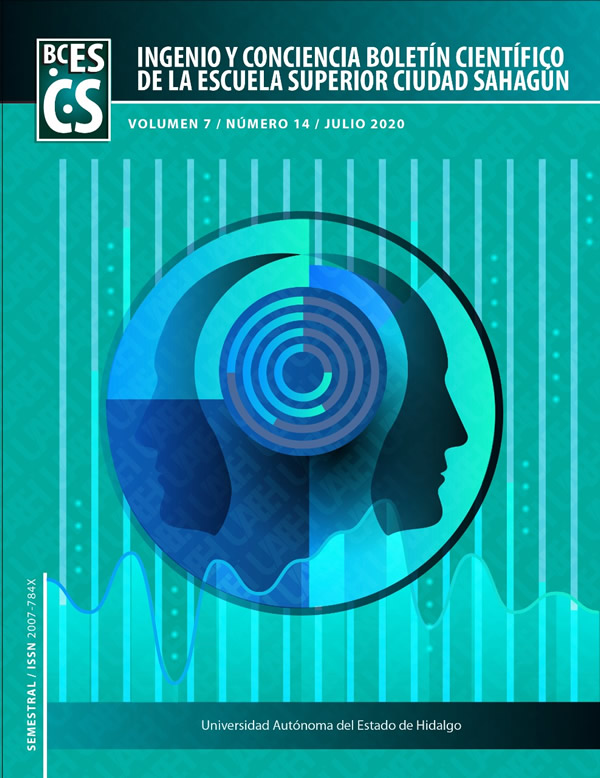Tratamientos termoquímicos
DOI:
https://doi.org/10.29057/escs.v7i14.5686Palabras clave:
tratamiento termoquímico, dureza, difusión, capa, superficieResumen
En el presente trabajo, se hace un descripción muy general de los principales tratamientos termoquímicos empleados para mejorar las propiedades en la superficie de diversos sustratos. La ingeniería de superficies representa un método técnicamente atractivo y económicamente viable para mejorar la capa superficial de los materiales. Dado que la superficie del material controla la vida útil en muchas aplicaciones, el objetivo es desarrollar una amplia gama de propiedades funcionales que son diferentes del sustrato base, incluyendo las físicas, químicas, eléctricas, electrónicas, magnéticas o mecánicas. Como parte de la ingeniería de superficies, el tratamiento termoquímico emplea la difusión térmica para incorporar átomos no metálicos o metálicos en la superficie del material para modificar su química y microestructura. Los tratamientos termoquímicos se pueden realizar en medios sólidos, líquidos o gaseosos con uno o varios elementos químicos activos simultáneamente. Para la mayoría de los tratamientos termoquímicos, el mecanismo incluye la descomposición de especies sólidas, líquidas o gaseosas, la división de moléculas gaseosas para formar átomos nacientes, la absorción de átomos, su difusión en una red metálica y reacciones dentro de la estructura del sustrato para modificar fases existentes o formar nuevas.
Descargas
Información de Publicación
Perfiles de revisores N/D
Declaraciones del autor
Indexado en
- Sociedad académica
- N/D
Citas
Davis, J. R. (2002) Surface Hardening of Steels: Understanding the basics. OHIO: ASM International.
Lampman, S. (1991). Introduction to Surface Hardening of Steels. In Heat Treating (Vol. 4, pp. 259-267). ASM Handbook.
Díaz del Castillo, F. (2007). Endurecimiento superficial del acero. In Lecturas de ingeniería (Vol. 1, p. 48). Ciudad de México, México: FES-Cuautitlán.
Judith C. Chow, Jian Zhen Yu, John G. Watson, Steven Sai Hang Ho, Theresa L. Bohannan, Michael D. Hays & Kochy K. Fung (2007) The application of thermal methods for determining chemical composition of carbonaceous aerosols: A review, Journal of Environmental Science and Health, Part A, 42:11, 1521-1541, DOI: 10.1080/10934520701513365
Zhen-Yu Xi, You-Yi Xu, Li-Ping Zhu, Yue Wang, Bao-Ku Zhu, A facile method of surface modification for hydrophobic polymer membranes based on the adhesive behavior of poly(DOPA) and poly(dopamine), Journal of Membrane Science, 327 (2009) 1–2, P. 244-253.
Budiniski, K. G. (1988). Surface Engineering for Wear Resistance. Prentice-Hall.
Amelse, J. A., Butt, J. B., Schwartz, L. H., Carburization of supported iron synthesis catalysts, The Journal of Physical Chemistry, 82 (1978) 5; 558-563. https://doi.org/10.1021/j100494a012
S. Geng, W. Ding, S. Guo, X. Zou, Y. Zhang, X. Lu. (2015) Carbon deposition on iron surfaces in CO–CO2 atmosphere. Ironmaking & Steelmaking 42:9, pages 714-720.
Tong, W. P., Tao, N. R., Wang, Z. B., Lu, J., Lu, K., Nitriding Iron at Lower Temperatures, Science, 299 (2003) 686-688, http://science.sciencemag.org/content/299/5607/686.abstract
Hudis,M., Study of ion‐nitriding, Journal of Applied Physics, 44 (1973) 1489-1496, https://doi.org/10.1063/1.1662398
E. Bezerra de Menezes Netto, Madeira Kliauga, A., Plaut, R., & Padilha, A. (2003). Liquid, gaseous and plasma nitrocarburizing using three different stainless steel types as a substrate (austenite, ferritic and duplex): A comparative study. Revue De Métallurgie, 100(1), 83-91. doi:10.1051/metal:2003149
K. Genel, Boriding kinetics of H13 steel, Vacuum, 80 (2006) 5, Pages 451-457, https://doi.org/10.1016/j.vacuum.2005.07.013
K. Genel, I. Ozbek, C. Bindal, Kinetics of boriding of AISI W1 steel, Materials Science and Engineering: A, 347 (2003) 1–2, Pages 311-314, https://doi.org/10.1016/S0921-5093(02)00607-X.
I. Campos, J. Oseguera, U. Figueroa, J.A Garcı́a, O. Bautista, G. Kelemenis, Kinetic study of boron diffusion in the paste-boriding process, Materials Science and Engineering: A, 352 (2003)261-265, https://doi.org/10.1016/S0921-5093(02)00910-3.
Graf von Matuschka, A. (1980). Boronizing, Munich: Carl Hanser Verlag
Sinha, A. K.. Boriding (Boronizing). En ASM Handbook (Vol. 4) (1991) (pp. 437 – 447). Ohio: ASM International.
Gopalakrishnan, A., K.K. Lal and A.G. Ponniah, 1999. Conservation of the Nilgiri rainbow trout in India. Naga, ICLARM Q. 22(3):16-19.
Sørensen, Mads R., Jacobsen, Karsten W., Jónsson, Hannes, Thermal Diffusion Processes in Metal-Tip-Surface Interactions: Contact Formation and Adatom Mobility, Physical Review Letters, 77 (1996) 5067-5070.
Eyre, T. S. (1975). Effect of boronising on friction and wear of ferrous metals Wear, 34(3), 383-397.
Singhal, S. C. (1977). A hard diffusion boride coating for ferrous materials. Thin Solid Films, 45,
V. Y. Skeeba et al., "Numerical Modeling of Steel Surface Hardening in the Process of High Energy Heating by High Frequency Currents", Applied Mechanics and Materials, 698 (2015) pp. 288-293.
N.Y. Sari, M. Yilmaz, Investigation of abrasive+erosive wear behaviour of surface hardening methods applied to AISI 1050 steel, Materials & Design, 27 (2006) pp. 470-478, https://doi.org/10.1016/j.matdes.2004.11.020.
Zenker, R., & Mueller, M. (1988). Electron Beam Hardening,Part I, Principles, Process Technology and Properties. In Heat Treat. Met. (Vol. 15, pp. 79-88).
Zenker, R., John, W., Rathjen, D., & Fritsche, G. (1989). Electron Beam Hardening, Part 2, Influence on Microstructure and Properties. In Heat Treat. Met. (Vol. 16, pp. 43-51).
Krauss, G. (1992). Advanced Surface Modification of Steels. Journal of Heat Treating, 9(2), 81-89.
Davis, J.R., (2001), Surface Engineering for Corrosion and Wear Resistance, ASM International, US
Robert B. Heimann, Thermal spraying of biomaterials, Surface and Coatings Technology, 201 (2006) pp. 2012-2019, https://doi.org/10.1016/j.surfcoat.2006.04.052
J.C Tan, L Looney, M.S.J Hashmi, Component repair using HVOF thermal spraying, Journal of Materials Processing Technology, 92–93 (1999) pp. 203-208, https://doi.org/10.1016/S0924-0136(99)00113-2.
Frigaard, Ø., Grong, Ø. & Midling, O.T. Metall and Mat Trans A (2001) 32: 1189. https://doi.org/10.1007/s11661-001-0128-4
Jae-Hyung Cho, Donald E. Boyce, Paul R. Dawson, Modeling strain hardening and texture evolution in friction stir welding of stainless steel, Materials Science and Engineering: A, 398 (2005), pp. 146-163, https://doi.org/10.1016/j.msea.2005.03.002.
O. O. Diniz Neto, R. Vilar, Physical–computational model to describe the interaction between a laser beam and a powder jet in laser surface processing, Journal of Laser Applications, 14 (2002) pp 46-51, https://lia.scitation.org/doi/abs/10.2351/1.1436485
J.G. Smeggil, A.W. Funkenbusch, N.S. Bornstein, The effects of laser surface processing on the thermally grown oxide scale formed on an Ni-Cr-Al-Y composition, Thin Solid Films, 119 (1984) pp. 327-335, https://doi.org/10.1016/0040-6090(84)90016-6.



















